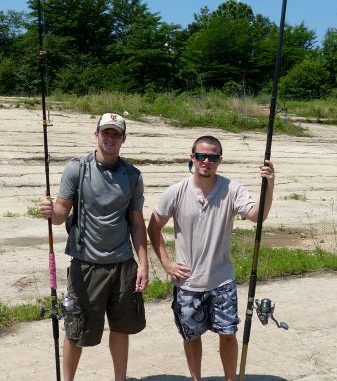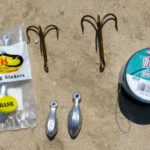
Looking for a different way to put some fish on the bank? These veteran snaggers share the secrets to their successes.
There are about as many ways to catch catfish as there are ways to cook them. Rods, yo-yos, jugs, trotlines, nets, traps and limb lines are all employed by Louisiana sportsmen.
Less common, but growing in popularity, is snagging the slimy fellows.
Snagging, which usually takes place below a dam or weir, requires a sturdy surf-fishing rod, stout line, large treble hook and hefty weight. Long casts are made across the water’s current, and the hook is retrieved with repeated jerks of the rod.
The idea is to snag suspended catfish and haul them in.
Jacob Coldiron and Rudy Horne are veteran snaggers who shared their expertise one hot spring day at Catahoula Lake’s diversion canal.
Standing on the rocks near the dam, Coldiron explained that the snagging technique is pretty simple.
“Throw it out as far as you can, and then jerk it back, reel in the line, jerk and reel,” he said. “Here in the diversion canal it’s not that wide or deep, so you’re only going to get a couple of jerks per cast.
“The most-important thing is to always keep your hook in moving water, either dragging it across the current or against it. You also have to snag and reel and snag and reel very quickly to keep the hook from settling on the bottom and hanging on something.”
Both men reared back, loaded their rods and shot the weighted hooks 50 yards or more out into the canal. The 2-ounce sinkers made a loud “ploop” when they hit the water, and Coldiron and Horne immediately began snatching.
Coldiron used a quick snap and had a rhythm so fast that it made me tired just watching.
“In shallow water like this,” he explained, “you have to use a quick jerking motion with the rod to keep the hook off the bottom, but if you’re in deep water — like at Simmesport — you can use more of a sideways sweeping action.
“It just takes experience to get the feel for it.”
After only a few casts, Horne’s line twisted around the rod, and the hook fell to the bottom and hung up. Wrapping the line around the reel a few times, he simply walked backwards up the bank until the line pulled taught.
“Listen to this,” said Horne, grinning.
When the line snapped it sounded just like a .22 going off.
Horne replaced his tackle, made another cast and almost immediately snagged a small spoonbill catfish. Gingerly removing the hook, he squatted down and began moving the fish to force water through its gills.
“An old man showed me how to move them back and forth in the water to revive them,” he said. “If you don’t, they just seem to give up and die.”
The spoonbill quickly revived and scooted back into the muddy water.
Coldiron moved over onto the dam where the water was rolling through the gates, and quickly snagged and released a needle nose gar. He then demonstrated what he called the “old man’s way” of snagging.
“My uncle is sort of lazy, and he showed me how to do this,” he said.
Instead of jerking the hook back to him like he did from the shore, Coldiron made a long cast downstream and let the current stretch his line taught. He then gave it a big jerk, and the current straighten the line out again.
“If you snag directly against the current you don’t have to constantly snag and reel,” he said. “It’s a much easier way to fish.”
While the diversion canal holds some good fish, both men prefer the deeper water of the Atchafalaya at Simmesport.
“I’ve always had my best luck at Simmesport,” Horne explained. “You can go out there and just catch a ton of them. It sometimes can get ridiculous.”
And the anglers catch some really nice fish this way.
“The biggest one I’ve landed was a spoonbill that probably went about 40 pounds,” Horne said. “I’ve also snagged some pretty decent-sized blue cats.”
A couple of hours at the diversion canal only produced some gar, shad and small spoonbills so we decided to drive down the levee to the Cypress Bayou weir.
Almost immediately after beginning to fish, Horne snagged something that put a big bow in his rod, but then it came off.
He made another cast to the same spot and snagged something again. This time when Horne reeled in the hook, what appeared to be a large buffalo scale was imbedded on one barb.
Coldiron explained that you never know what you might snag.
“I was at the Archie weir on Little River one time and snagged something so solid I fell flat on my butt,” he said. “It looked like a car rolled in the water in front of me, but it then came loose. It probably was a big old carp, but I don’t know for sure.”
Since he never knows what he might have on the other end of his line, Horne doesn’t horse his catch in.
“I usually let them run a bit,” he said. “Just let them take 30 or 40 yards of line while keeping tension on it. Then reel some, let them play, reel, let them play and work them back to the bank.
“You have to play them.”
I had been satisfied to watch my hosts at work, but Horne eventually handed over his 12-foot rod.
“Come on, don’t you think you ought to try it?” he asked.
I stepped up to the plate, but found the big rig to be awkward to cast. After a few tries and some coaching tips from Horne, however, I finally slung it far enough to start snagging.
Then it was a struggle to reel quickly enough to keep the weight off the bottom. In just a few minutes I was sweating bullets.
Snagging, it turns out, is a young man’s game (or old man who’s in better shape than me). But if you’re up for it, there’s no more exciting way to fill your freezer with fillets.





